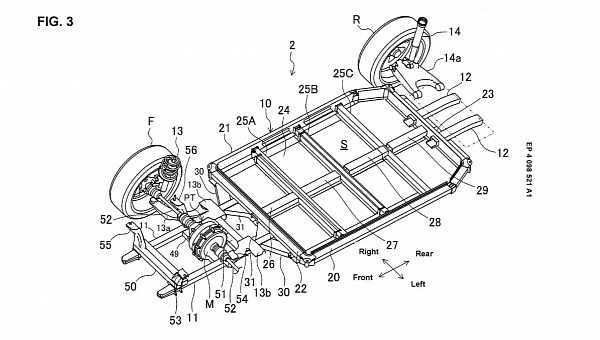Mazda made a pretty big effort to enlighten everyone about its EV strategy. It would only give its vehicles battery packs that were large enough for them to still be great to drive. When it presented the MX-30, all its arguments about how important it was that an EV was light went down the drain with a range of only 100 miles (160 kilometers). A new patent application shows the Japanese automaker will change that strategy soon.
The electric vehicle pictured in the file revealed by The Drive has an amazingly thin battery pack. It is probably similar to the one Renault gave the Megane E-TECH, or SAIC adopted on the MG4: both are only 4.3 inches (11 centimeters) thick. It may be even thinner, but what really matters is what the patent description disclosed.
The document stated that the battery pack could contain regular lithium-ion cells or perhaps solid-state batteries. Although it is doubtful that Mazda will be the first company to sell an EV with these babies, that shows the Japanese carmaker is following the same drive its competitors already revealed. Toyota and Honda have been very clear that they don’t believe the current battery technology will suffice for massive EV adoption. So much so that they are waiting for solid-state batteries to be more ambitious.
Mazda probably cannot wait that long. It was never among the largest Japanese carmaker and has always followed daring paths, such as trying to develop rotary engines. The patent may show it will speed up in offering more EVs, mainly because a Mazda 3 replacement would be as versatile as it would have to be accessible.
The versatility comes from the body types it can adopt without much effort: sedan, hatchback, and station wagon. With a little more work, we could also talk about SUVs or crossovers. Mazda said the new car could have a motor on the front axle, the rear axle, or both of them. Being affordable is a need for a vehicle in this market segment.
In the patent images, figure 3 suggests Mazda will still prefer the least obvious path with electric cars. The motor in the vehicle seems too narrow to be like the radial-flux units most EVs present. That means it is probably an axial-flux motor, which is lighter and more powerful than the solution most used nowadays. Considering how concerned Mazda is to keep mass to the minimum possible, it makes perfect sense. Some will complain that the motor powers the front wheels, but so does the one in the current Mazda 3.
We are yet to learn how this future vehicle will change the Japanese carmaker’s electrification plans or if they will remain the same. In 2020, Mazda filed a patent application that said it would use supercapacitors and in-wheel motors, but it was a much more generic drawing than the one The Drive published. In other words, we would take the “Mazda 3” replacement pretty seriously: we may see it soon in dealerships.
The document stated that the battery pack could contain regular lithium-ion cells or perhaps solid-state batteries. Although it is doubtful that Mazda will be the first company to sell an EV with these babies, that shows the Japanese carmaker is following the same drive its competitors already revealed. Toyota and Honda have been very clear that they don’t believe the current battery technology will suffice for massive EV adoption. So much so that they are waiting for solid-state batteries to be more ambitious.
Mazda probably cannot wait that long. It was never among the largest Japanese carmaker and has always followed daring paths, such as trying to develop rotary engines. The patent may show it will speed up in offering more EVs, mainly because a Mazda 3 replacement would be as versatile as it would have to be accessible.
The versatility comes from the body types it can adopt without much effort: sedan, hatchback, and station wagon. With a little more work, we could also talk about SUVs or crossovers. Mazda said the new car could have a motor on the front axle, the rear axle, or both of them. Being affordable is a need for a vehicle in this market segment.
In the patent images, figure 3 suggests Mazda will still prefer the least obvious path with electric cars. The motor in the vehicle seems too narrow to be like the radial-flux units most EVs present. That means it is probably an axial-flux motor, which is lighter and more powerful than the solution most used nowadays. Considering how concerned Mazda is to keep mass to the minimum possible, it makes perfect sense. Some will complain that the motor powers the front wheels, but so does the one in the current Mazda 3.
We are yet to learn how this future vehicle will change the Japanese carmaker’s electrification plans or if they will remain the same. In 2020, Mazda filed a patent application that said it would use supercapacitors and in-wheel motors, but it was a much more generic drawing than the one The Drive published. In other words, we would take the “Mazda 3” replacement pretty seriously: we may see it soon in dealerships.













